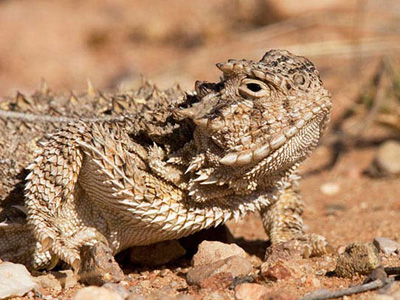Amphibians and reptiles may occupy similar habitats and can be found in most habitat types. Some species use different habitats at different times of the year. Some turtles, for example, spend most of their time in the water, but must move to land to lay eggs.

© Robert shantz
Many salamanders inhabit upland habitats for most of the year, but require temporary or permanent wetlands or aquatic sites to breed and lay eggs. Additionally, many herpetofauna species become less active during periods of extreme cold or heat, and at such times they seek out protected sites. Depending on the species and location, amphibians may need sites for burrowing in moist soil or wet areas to keep their skin moist (Marks 2006). Near wetlands and riparian areas, amphibians use a variety of upland microhabitats, including leaf litter, woody material, small mammal burrows, and boulders and cracks in rocks.
From a study in Big Bend National Park (NP; i.e., Dayton et al. 2004), researchers found that soil type appeared to be a good indicator of the presence or absence of four common desert anurans (frogs and toads)— Couch’s spadefoots (Scaphiopus couchii), red-spotted toads (Bufo punctatus), Texas toads (Bufo speciosus), and Western green toads (Bufo debilis insidior). The species were disproportionately associated with soils characterized as frequently inundated with a relatively high clay content. Species richness and abundance were highest in Tornillo and Glendale-Harkey soils; almost half of all the anurans detected were found in these two soil types, but the soils comprised only 12% of the available soil along the research transects. Of the species found on Tornillo and Glendale-Harkey soils, the vast majority were Couch’s spadefoots and Texas toads, both species that burrow.
Reptiles require sites that contain shelter from the heat and basking areas in the sun. Microhabitats used during times of extreme cold or heat include rock piles or outcroppings, animal burrows, woody material, and brush piles. Many snakes and lizards would also find these suitable areas for nesting. A description of adaptations of amphibians and reptiles for living in desert environments is found in Van Devender (2000). These adaptations include the ability to excavate deep burrows where the animal may stay for substantial periods of time (e.g., Couch’s spadefoot, which is aided in digging by spades on its hind feet). Some reptiles, such as the Gila monster (Heloderma suspectum, which occurs in the Chihuahuan Desert but not in the CHDN), store water in the fatty tissues of their tails. Adaptations also exist for living in loose, windblown sand. For example, the fringe-toed lizard (Uma spp.) gains traction while running across dunes with the fringe-like scales on the elongated toes of its back feet.
Amphibians and reptiles are both important members of aquatic and terrestrial ecosystems. Both groups serve as both predators and prey, and species that inhabit both ecosystems serve to transfer energy between the two systems. Amphibians are viewed as indicators of wetland ecosystem health. They are sensitive to a variety of threats and, thus, can serve as early indicators of ecosystem change when monitored over long time scales. Changes in amphibian populations can often be linked to one of the following causes, all of which suggest a decrease in overall ecosystem health: pollution, introduced species, drought, habitat destruction, disease, and ultraviolet radiation. Amphibian populations may exhibit measurable changes in site occupancy, distribution, abundance, species richness, disease occurrence, and malformations. These changes have cascading effects on other aspects of the ecosystem, such as predator, prey, and competitor populations, energy flow, and nutrient cycling (Stebbins and Cohen 1995).
Activity and behavior of both amphibians and reptiles are affected by local weather conditions during the year. For example, lower rainfall and higher temperatures can significantly affect microhabitat in an area and reduce the likelihood of observing amphibians, and, to a lesser extent, reptiles, for some period of time. This may result in lower recorded population levels during subsequent seasons and years. Similarly, daily activity of reptiles may be affected by rain and/or cold weather. These effects of local weather conditions can hamper short-term studies of herpetofauna, especially in the dry Southwest (Johnson and Lowe 1979, Lowe and Holm 1991). Effects of drought on herpetofauna are discussed further in the next chapter under “Drought.”
Part of a series of articles titled Amphibians and Reptiles in the Chihuahuan Desert.
Last updated: February 23, 2017
